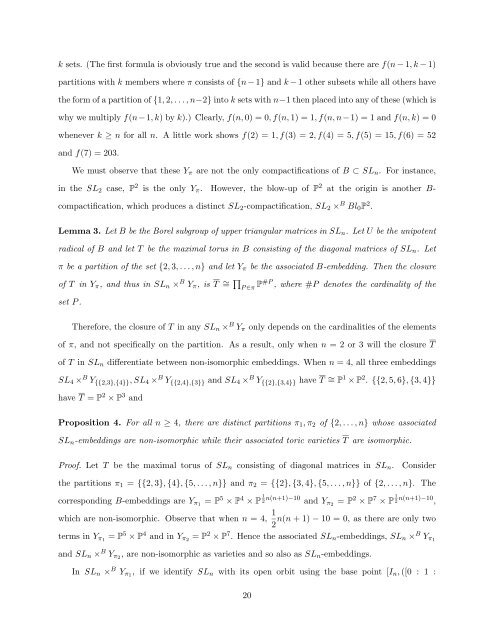Equivariant Embeddings of Algebraic Groups
Equivariant Embeddings of Algebraic Groups
Equivariant Embeddings of Algebraic Groups
You also want an ePaper? Increase the reach of your titles
YUMPU automatically turns print PDFs into web optimized ePapers that Google loves.
k sets. (The first formula is obviously true and the second is valid because there are f(n − 1, k − 1)<br />
partitions with k members where π consists <strong>of</strong> {n − 1} and k − 1 other subsets while all others have<br />
the form <strong>of</strong> a partition <strong>of</strong> {1, 2, . . . , n−2} into k sets with n−1 then placed into any <strong>of</strong> these (which is<br />
why we multiply f(n−1, k) by k).) Clearly, f(n, 0) = 0, f(n, 1) = 1, f(n, n−1) = 1 and f(n, k) = 0<br />
whenever k ≥ n for all n. A little work shows f(2) = 1, f(3) = 2, f(4) = 5, f(5) = 15, f(6) = 52<br />
and f(7) = 203.<br />
We must observe that these Y π are not the only compactifications <strong>of</strong> B ⊂ SL n . For instance,<br />
in the SL 2 case, P 2 is the only Y π . However, the blow-up <strong>of</strong> P 2 at the origin is another B-<br />
compactification, which produces a distinct SL 2 -compactification, SL 2 × B Bl 0 P 2 .<br />
Lemma 3. Let B be the Borel subgroup <strong>of</strong> upper triangular matrices in SL n . Let U be the unipotent<br />
radical <strong>of</strong> B and let T be the maximal torus in B consisting <strong>of</strong> the diagonal matrices <strong>of</strong> SL n . Let<br />
π be a partition <strong>of</strong> the set {2, 3, . . . , n} and let Y π be the associated B-embedding. Then the closure<br />
<strong>of</strong> T in Y π , and thus in SL n × B Y π , is T ∼ = ∏ P ∈π P#P , where #P denotes the cardinality <strong>of</strong> the<br />
set P .<br />
Therefore, the closure <strong>of</strong> T in any SL n × B Y π only depends on the cardinalities <strong>of</strong> the elements<br />
<strong>of</strong> π, and not specifically on the partition. As a result, only when n = 2 or 3 will the closure T<br />
<strong>of</strong> T in SL n differentiate between non-isomorphic embeddings. When n = 4, all three embeddings<br />
SL 4 × B Y {{2,3},{4}} , SL 4 × B Y {{2,4},{3}} and SL 4 × B Y {{2},{3,4}} have T ∼ = P 1 × P 2 . {{2, 5, 6}, {3, 4}}<br />
have T = P 2 × P 3 and<br />
Proposition 4. For all n ≥ 4, there are distinct partitions π 1 , π 2 <strong>of</strong> {2, . . . , n} whose associated<br />
SL n -embeddings are non-isomorphic while their associated toric varieties T are isomorphic.<br />
Pro<strong>of</strong>. Let T be the maximal torus <strong>of</strong> SL n consisting <strong>of</strong> diagonal matrices in SL n .<br />
Consider<br />
the partitions π 1 = {{2, 3}, {4}, {5, . . . , n}} and π 2 = {{2}, {3, 4}, {5, . . . , n}} <strong>of</strong> {2, . . . , n}. The<br />
corresponding B-embeddings are Y π1 = P 5 × P 4 × P 1 2 n(n+1)−10 and Y π2 = P 2 × P 7 × P 1 2 n(n+1)−10 ,<br />
which are non-isomorphic. Observe that when n = 4, 1 n(n + 1) − 10 = 0, as there are only two<br />
2<br />
terms in Y π1 = P 5 × P 4 and in Y π2 = P 2 × P 7 . Hence the associated SL n -embeddings, SL n × B Y π1<br />
and SL n × B Y π2 , are non-isomorphic as varieties and so also as SL n -embeddings.<br />
In SL n × B Y π1 , if we identify SL n with its open orbit using the base point [I n , ([0 : 1 :<br />
20
















